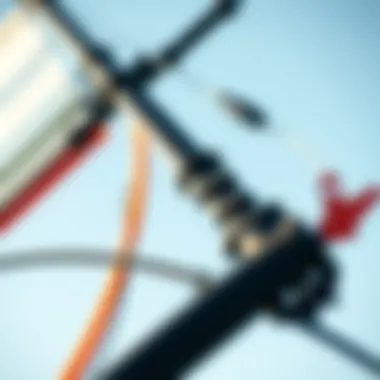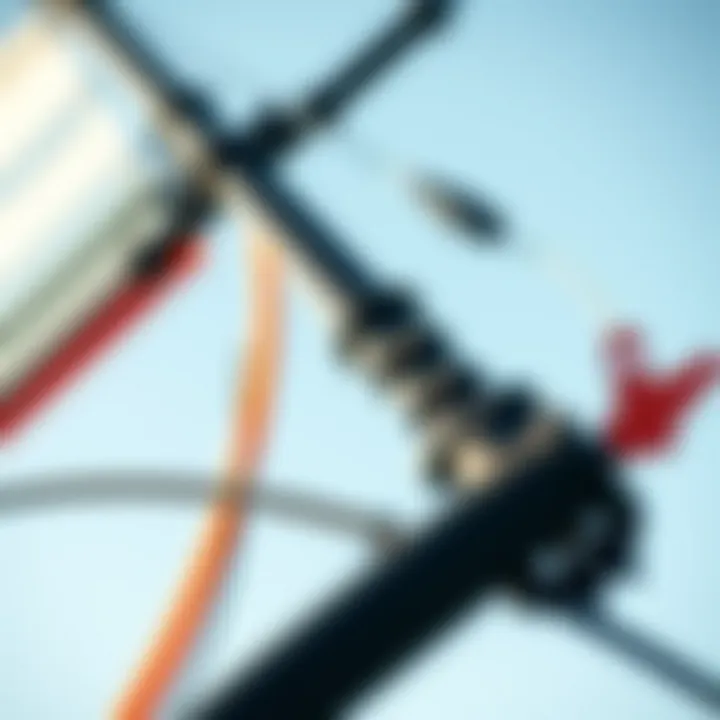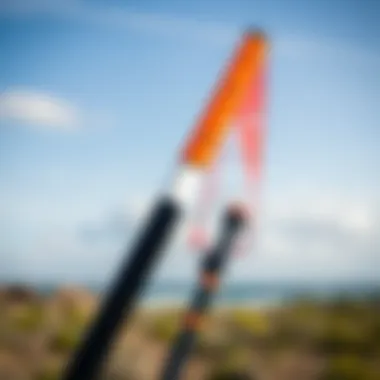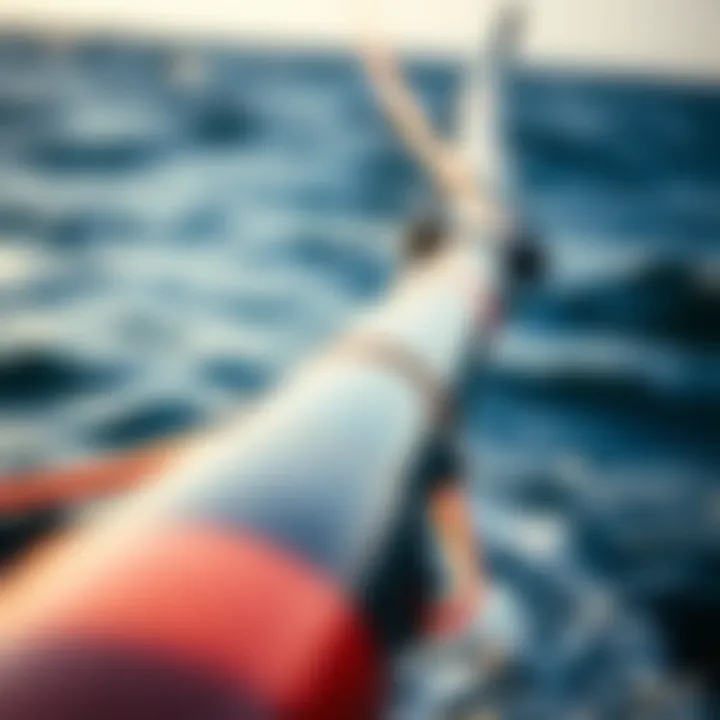Understanding Windsurf Masts: Design and Impact


Intro
Windsurfing, an exhilarating blend of surfing and sailing, has captured the hearts of many outdoor enthusiasts. At the heart of this sport lies the windsurf mast, a crucial piece of equipment that plays a pivotal role in controlling the sail and affecting performance. Understanding the intricacies of windsurf masts is not just for the manufacturers; it’s vital knowledge for anyone looking to enhance their windsurfing experience, whether you're a novice learning the ropes or an experienced sailor pushing your limits.
This guide aims to unpack the key elements of windsurf masts, delving into their design, materials, and how these factors influence the sport's dynamics. We'll also touch on maintenance tips to ensure your equipment stands the test of time, along with recommendations for gear that suits various skill levels.
Let’s journey into the fundamentals of windsurf masts, focusing on the unique features that set them apart and understanding how each decision—be it material type or mast length—can significantly alter your experience on the water.
Intro to Windsurf Masts
Windsurfing enthusiasts often find themselves lost in the thrill of gliding over water, but behind that exhilarating experience lies a crucial element that can significantly influence performance—the windsurf mast. Understanding masts is not just for the tech-savvy; it’s essential for anyone wanting to improve their windsurfing game.
The windsurf mast serves as the backbone of the entire rig. Its design and construction determine how effectively a sailor harnesses wind energy and how well the sail performs on the water. An optimal mast can lead to enhanced stability, better control, and overall improved handling while navigating various water conditions. However, selecting the right mast goes beyond just picking one that looks good. The construction materials, mast type, and even your own skill level play a pivotal role in dictating the sail’s responsiveness during riding.
With a plethora of choices available, understanding windsurf masts allows enthusiasts—from fledgling riders to seasoned veterans—to find the right gear tailored specifically to their needs. This section aims to lay the groundwork for the in-depth exploration of windsurf masts, addressing their significance not only in terms of performance but also their historical evolution, which lends insight into modern advancements in windsurfing technology.
Definition and Purpose of a Windsurf Mast
At its core, a windsurf mast acts as a vertical support system for the sail. Picture it as the column holding up an expansive tent against the breeze—a structure that needs to withstand both the pressure of the wind and the dynamic movements of the rider. Masts are crafted to transfer wind energy into forward motion while also providing a stable platform for maneuvering.
Masts must allow for flex without compromising strength; this is where material choice comes into play. Through flex, a mast can adapt to the wind’s forces, helping the sail to catch and utilize that air without losing control. The right mast can also help enhance the overall performance of various sails by affecting their angle and lift, thus playing into the overall dynamics of the windsurfing experience.
Historical Context of Windsurf Technology
Windsurfing, as we know it today, stems from a fascinating blend of innovation and adaptation, with masts evolving significantly over the decades. In the late 1960s and early 1970s, windsurfing equipment was rudimentary at best. Early designs featured wooden masts, which were prone to bending and breaking under high winds. However, in 1973, the introduction of lightweight materials such as fiberglass marked a turning point, allowing for more robust and reliable masts.
As technology advanced, so did the materials used in mast construction. The rise of carbon fiber in the late 1980s further transformed mast design, allowing for even lighter and stiffer options. The shift from aluminum to composite materials not only reduced weight but also offered better flex characteristics, thereby enhancing performance. Each technological leap reflected the growing demands of athletes seeking higher speeds and better responsiveness on the water. Today, understanding the progression of windsail masts provides an Eastern compass to navigate modern advancements in the sport, helping enthusiasts appreciate the engineering that goes into achieving peak performance.
"A windsurf mast is not merely a stick; it is a finely-tuned instrument that performs in harmony with both the sail and the sailor, enhancing the art of gliding across water."
Anatomy of a Windsurf Mast
The anatomy of a windsurf mast is as crucial as the sail it supports. Understanding its basic structure not only enhances the windsurfing experience but also aids in making informed decisions about mast selection. A well-constructed mast can profoundly impact performance on the water, influencing factors like speed, maneuverability, and control. Thus, delving into the materials and components of the mast can provide valuable insights for enthusiasts at any level.
Materials Used in Mast Construction
Different materials play unique roles in the construction of windsurfing masts. Each type brings its own set of characteristics that affect performance and durability, defining how a sail reacts in various conditions.
Fiberglass
Fiberglass has been a go-to material in mast construction for quite a while, thanks to its balance of flexibility and strength. The key characteristic of fiberglass is its resistance to breakage, making it a reliable choice for beginners and recreationists.
Its unique feature is affordability. Compared to more advanced materials like carbon fiber, fiberglass masts are easier on the wallet, yet they still offer decent performance. However, the downside is that they tend to be heavier, which might impact agility in gusty winds.
Carbon Fiber
Carbon fiber is a solid favorite among advanced windsurfers for its high strength-to-weight ratio. The big draw here is its lightweight nature, which allows for more responsive handling and faster speeds. A carbon fiber mast can bend without losing its shape, a characteristic that enhances the overall power and performance of the sail.
However, the trade-off is cost. Carbon fiber masts can be quite pricey, making them more suitable for serious athletes and coaches. Despite the investment, the performance boost often outweighs the initial expense.
Aluminium
Aluminium masts bring a mix of benefits that appeal to a broad audience, balancing quality and price. One significant characteristic of aluminum is its durability; these masts can withstand rough handling and various environmental conditions, making them a popular choice for beginner windsurfers.
The unique feature of aluminium masts is their versatility. They can often be used across different windsurfing disciplines, making them an excellent all-rounder. However, some downsides include greater weight compared to fiberglass and carbon fiber, which can affect maneuvers and overall performance.
Key Components of the Mast
Masts consist of several key components that are integral to their function, each contributing in its own way to the windsurfing experience.
Cuff
The cuff is the section at the base of the mast, connecting it to the extension and ultimately the sail. Its primary role is to provide a stable foundation. A well-designed cuff can allow for better responsiveness to wind shifts, making it a popular choice for racers wanting every ounce of control. A unique feature of the cuff is the varying designs that can help minimize drag, which is crucial for maintaining speed.
However, it's important for users to check for wear and tear, as a worn cuff can lead to performance issues, potentially impacting the overall sailing experience.


Taper
The taper refers to the gradual narrowing of the mast from base to tip. This design is pivotal in optimizing how the mast bends, which can enhance both speed and control. Tapering contributes to a smoother flow of air over the sail, making it a beneficial aspect for anyone looking to maximize performance.
The unique aspect of the taper is its ability to fine-tune the mast's flex characteristics, which can then be adjusted to suit individual preferences and conditions. However, achieving the right taper for specific sailing styles often requires a learning curve, as not all designs may yield the expected improvements.
Base
The base is the anchor of the mast, allowing it to connect firmly to the board. It plays a pivotal role in transmitting the forces generated by the sail to the board. A solid base stabilizes the windsurfing setup, which is particularly important for beginners who are still getting accustomed to balance.
The unique feature of the base is its customizable nature. Users can choose different base systems according to their needs, further tailoring their setup. However, it's vital to ensure compatibility with the mast and board to prevent performance setbacks.
Understanding the anatomy of a windsurf mast is not just about structure; it's about how these elements interact and influence your entire windsurfing experience.
By grasping these foundational aspects of windsurf masts, enthusiasts can better appreciate their equipment and make informed decisions, ultimately enhancing their time on the water.
Types of Windsurf Masts
Understanding the different types of windsurf masts is critical for enthusiasts aiming to optimize their performance on the water. Selecting the right mast is not just a matter of preference but can significantly affect your experience, from stability to responsiveness during sailing. Each type of mast offers unique characteristics that cater to various skill levels, sail sizes, and wind conditions. Here, we delve into the three primary types of windsurf masts: RDM, SDM, and Adjustable Masts, providing insights that can help you select the best option for your personal windsurfing journey.
RDM (Reduced Diameter Masts)
RDMs have gained popularity for a number of reasons, primarily their flexibility and how they respond to wind conditions. The design of reduced diameter masts allows for increased bend characteristics, making them ideal for smaller sails or lighter winds.
When it comes down to maneuverability, RDMs shine. Their reduced diameter makes them easier to handle, particularly for beginners or those transitioning from recreational to more competitive windsurfing. One significant advantage of RDMs is that they offer a softer feel, allowing for a smoother power delivery. This characteristic can help sailors harness gusts more effectively and maintain control over their rig.
However, there are some considerations to keep in mind. RDMs may lack the stiffness of standard masts, which means they might not perform as well in high wind situations. Therefore, it's crucial to assess your typical windsurfing conditions before choosing an RDM.
SDM (Standard Diameter Masts)
In contrast to RDMs, SDMs are characterized by their standard diameter, which makes them more rigid. This rigidity is beneficial for larger sails and higher wind conditions, providing essential stability when combating gusty weather. SDMs are the bread and butter for many intermediate to advanced windsurfers. Their construction usually results in increased durability as well, making them a reliable choice for those who often engage in more aggressive sailing.
One of the standout features of SDMs is their ability to maintain shape under pressure. When you're tearing through choppy waters or taking on waves, the rigidity of an SDM mast helps maintain sail efficiency. However, keep in mind that these masts can be more challenging for newcomers to handle, given their weight and stiffness. They may require a bit more muscle to manage, especially in tricky conditions.
Adjustable Masts
Lastly, adjustable masts have carved out their niche among the windsurfing community. As the name suggests, these masts allow sailors to change the height of the rig, providing versatility across different wind conditions and sail sizes. If you like to experiment with various setups, adjustable masts present an attractive option.
The ability to customize the mast length can lead to improved performance. Shortening the mast can enhance control in high winds or when navigating challenging water surfaces, while extending it can help catch more wind in lighter conditions.
Though the benefits are significant, there can be some drawbacks. Adjustable masts typically come with a bit more complexity, which may deter those who prefer a straightforward approach. Maintenance can also be an issue if the adjustment mechanism isn't carefully monitored. Nevertheless, for those willing to put in the time, the adaptability of adjustable masts can lead to an improved and personalized windsurfing experience.
"The right mast can make all the difference in how you experience the wind and waves. From flexibility to rigidity, choosing wisely is a skill worth honing."
By understanding the specific characteristics of each type of mast, enthusiasts can better tailor their equipment to suit their unique sailing styles and conditions, ensuring a more enjoyable and effective windsurfing experience.
Selecting the Right Windsurf Mast
Choosing the right windsurf mast can be the difference between an exhilarating ride and a cumbersome experience on the water. The correct mast not only maximizes your performance but also enhances your overall enjoyment. Each windsurfing adventure hinges on several considerations that you must account for to make the best decision. Masts come in various sizes, materials, and configurations that directly affect their behavior on the water. Understanding these elements allows you to find a mast tailored to your unique style and conditions.
Factors to Consider
Skill Level
Your skill level plays a pivotal role in the choice of mast. Beginners often require masts that are sturdy and forgiving to avoid frustrating moments during their learning curve. As you progress and gain confidence, you might prefer stiffer masts that provide better performance.
A beginner-friendly mast typically offers a more flexible design. This flexibility allows for easier handling and reduces the likelihood of falls or mishaps. Conversely, advanced riders may seek out stiffer masts which respond quickly to input and provide enhanced speed and control. The balance here is crucial; picking something too advanced for your skill level might lead to a frustrating experience, while an overly flexible option may limit your growth.
Sail Size Compatibility
The compatibility of the mast with your sail size is crucial. Masts are not one-size-fits-all; each sail has specific dimensions for optimal performance. Mismatching these can lead to subpar sailing experiences.
When you buy a sail, it usually suggests a corresponding mast size. The right fit ensures that when the wind catches the sail, the entire rig operates smoothly. An incompatible mast can either be too weak, impacting control, or too stiff, causing inefficiencies in wind capture. The relationship between sail and mast isn’t merely about dimensions; it’s about creating a well-rounded system that allows you to harness the wind effectively.
Wind Conditions
Understanding the wind conditions where you plan to sail is fundamental in selecting the proper mast. Windsurf masts react differently based on how stiff or flexible they are, affecting their performance in various wind environments.


In lighter winds, a more flexible mast can help catch the wind and allow a slower start, making it easier for beginner and intermediate sailors. However, in choppy or stronger wind conditions, a stiffer mast is beneficial. The added rigidity helps keep the sail steady under pressure, leading to better performance and more control. The connection between mast flexibility and wind conditions becomes clear when visualizing how each element plays a role in the dynamics of your ride.
Potential Pitfalls in Mast Selection
When diving into the selection process, it's easy to fall into a few common traps. One of the biggest is focusing too much on brand names without considering personal needs. Each rider is distinct; what works for one might not suit another. Additionally, not thoroughly understanding the specifics of performance and compatibility can lead to overlooking crucial details that directly affect your experience. Misjudging your requirements may result in a mismatch, one that could hinder your sailing adventures instead of boosting them.
Proper mast selection is all about finding the perfect balance between skill, sail size, and wind conditions. Misalignment in any of these areas can diminish your windsurfing experience significantly.
Impact of Mast on Performance
Understanding the role of a windsurf mast is crucial for anyone diving into the sport, whether as a hobbyist or serious racer. The mast isn’t just a piece of fiberglass, carbon, or aluminum stuck in the ground. It plays a pivotal part in determining how well one can harness the wind. The right mast ensures good performance, balance, and responsiveness, providing a smoother ride.
Mast Flex and Rig Tuning
Mast flex is perhaps one of the more misunderstood aspects of windsurfing. When we talk about flex, we refer to how much a mast bends under load, primarily from the sail’s pressure. This bending ability affects sail shape and, therefore, performance. For example, a mast that is too stiff might not allow the sail to rotate correctly, which could lead to a lackluster performance in varied conditions.
- Stiffer Masts: Ideal for higher wind even. They provide better control and less deformation, making them suitable for competitive environments.
- More Flexible Masts: These are forgiving and lend themselves to maneuvers. Ideal for lighter winds, they can help catch gusts better as they flex and load the sail more effectively.
When tuning your rig, understanding mast flex becomes imperative. Fine-tuning the downhaul and outhaul can lead to an optimal sail shape, allowing you to maximize potential speed or improve maneuverability as needed.
"The secret of being successful in windsurfing often lies in the little adjustments that make a big impact; learning to tune your mast is like finding hidden treasure."
Understanding Mast Positioning
Equally important to flex is mast positioning. The position of the mast in relation to the board and sail can affect balance and the feel of the rig significantly. Finding the sweet spot can be the difference between a smooth ride and a bone-rattling struggle.
- Forward Position: This positioning moves the mast closer to the nose of the board. It helps in light winds, making the helm feel more comfortable, which is essential for newer riders.
- Aft Position: Shifting the mast toward the tail increases speed and provides a responsive experience, particularly beneficial in high-speed runs or competitive settings.
- Balance Tuning: Experimenting with mast foot placement helps in achieving an ideal balance between control and speed. A well-balanced rig makes for a more enjoyable ride, reducing fatigue and allowing longer sessions on the water.
In summary, the mast isn't merely a stand; it's the backbone of performance in windsurfing. Understanding mast flex and positioning allows windsurfers to adapt their setups to a myriad of conditions, substantially influencing their overall experience. Choices in this realm don't just affect how one cuts through the water but can also escalate proficiency levels, turning novice riders into seasoned watersports enthusiasts.
Mast Maintenance Tips
Maintaining a windsurf mast isn't just a matter of keeping it shiny; it's about ensuring safety, enhancing performance, and prolonging its lifespan. Windsurfers, from enthusiasts to seasoned pros, know that the mast plays a crucial role in their overall experience on the water. A well-maintained mast can mean the difference between a smooth, successful ride and an unexpected mishap on the waves.
Cleaning and Storage Best Practices
Cleaning your windsurf mast is like giving it a relaxing spa day. After all, these masts endure a lot—saltwater, sand, and the rigors of ocean breezes.
- Rinse After Use: As soon as you're off the water, give your mast a good rinse with fresh water. This helps remove any salt that could corrode the materials over time.
- Gentle Cleaning Routine: Use a soft cloth or sponge to wipe down the mast. Avoid abrasive materials that could scratch the surface. If there's stubborn grime, a mild soap can work wonders.
- Inspect for Damage: This is a great opportunity to look for cracks, dents, or any wear and tear. Taking note of these issues early can save you headaches later.
When it comes to storage, treating your mast with care is essential. Here’s how:
- Choose a Cool, Dry Place: Avoid leaving your mast in direct sunlight or damp areas. This can deteriorate the materials over time.
- Avoid Pressure: When storing your mast, ensure it's not being pressed under other gear. Lay it flat or hang it up so that it maintains its shape.
- Use Protective Covers: If possible, invest in a mast bag. This not only protects against scratches but also keeps dust and dirt at bay.
By following these practices, you ensure that your gear remains in peak condition, ready to hit the waves at a moment's notice.
Common Repairs and Issues
Just like any equipment, windsurf masts can face their fair share of problems. Here’s a rundown of common issues and how to tackle them:
- Cracks and Dents: These can happen during transport, especially if the mast is not stored properly. If you notice cracks, it may need professional repairs. Dents can sometimes be heated gently to regain shape, but caution is wise here.
- Fittings and Ropes: Make sure to check the fastenings at the top and bottom of your mast. If they seem loose or worn, replacing them immediately can prevent catastrophic failures.
- Mast Extension Failure: If your mast uses extensions, examine them regularly. It's easy to overlook these small pieces, but they can wear down and fail, leaving you with a broken rig.
Regular maintenance checks save a ton of hassle down the line. Even just a few minutes after each session can ensure your gear remains reliable and effective.
Innovations in Windsurf Mast Technology
The evolution of windsurf masts has been astonishing in recent years, with developments that have significantly impacted performance on the water. For any windsurfing enthusiast, it’s important to understand how these innovations can influence not just your experience but your overall engagement with the sport. As we embrace newer technologies, the nuances within mast design and materials have brought forth both benefits and considerations that must be taken into account before making a purchase.
Emerging Materials and Designs
In the world of windsurfing, materials matter. Gone are the days when the choice was simply between a basic fiberglass mast or a bulky aluminum one. Nowadays, materials like carbon fiber and advanced composites have taken center stage in mast construction, leaving a profound impact on performance.
- Carbon Fiber offers a stunning strength-to-weight ratio that not only enhances a mast's durability but also allows for a lighter rig, making it easier to maneuver.
- Reinforced composites provide similar benefits, combining reduced weight with increased flexibility, which can help in adjusting to various sailing conditions more effectively.
- Recently, manufacturers have begun experimenting with unique blends of materials, developing masts that capitalize on the strengths of both fiberglass and carbon fiber, creating a more versatile piece of equipment.
These design shifts allow for customizations that were previously unheard of; for instance, interlocking sections in masts have evolved to create seamless connections, allowing for a sturdier structure with minimal weight. Thus, the right choice of materials can lead to not just performance gains but also the potential for a better riding experience, adapting to almost all wind conditions.
Technological Advances in Construction
Construction methodologies for windsurf masts have undergone revolutionary changes over the years. The intricacies of the manufacturing processes now play an integral role in determining the ideal characteristics for different windsurfing styles. A few aspects worth noting include:
- Precision Engineering: Masts are now constructed with greater accuracy due to advancements in tools and machinery, enabling manufacturers to create precise tapering, which affects the mast's flexibility and response.
- Automated Production Techniques: Manufacturers increasingly rely on automated processes that reduce human error and ensure consistency in quality across production runs. The result is a more reliable piece of equipment that can withstand rigorous use.
- 3D Modeling and Simulation: Engineers are utilizing 3D technology to simulate how a mast will behave under various conditions before it even gets produced. This leads to innovations in design that optimize how a mast performs in real-world scenarios.


Emerging technologies like these are paving the way for more effective designs, catered specifically to the needs of athletes and hobbyists alike. Understanding these innovations in mast technology can give enthusiasts a competitive edge or simply enhance their enjoyment on the water.
"Advancements in mast technology are not just about performance; they also highlight the growing synergy between design and user experience."
By investing in a mast that incorporates these latest innovations, windsurfers can elevate their sailing experience, navigating efficiently through variable wind conditions and ultimately transforming their time on the water into something truly remarkable.
Windsurfing Community and Mast Preferences
When it comes to windsurfing, the sheer enthusiasm of the community plays a significant role in shaping one's understanding and preferences for masts. Like any sport, the community not only provides a support network but also imparts valuable knowledge that can be crucial for all levels of enthusiasts. From beginners fumbling through their first sessions to seasoned pros perfecting their style, insights from fellow windsurfers can illuminate the path to better mast choices.
Expert Recommendations
Advice from industry professionals and veterans can help newcomers navigate the overwhelming sea of options available today. Experts often emphasize that choosing the right mast isn't just about brand preference or flashy designs; it's about compatibility with sail size and wind conditions.
- Consider skill level: Beginners might be steered toward more forgiving masts that provide stability and ease of handling. Experts recommend masts with a softer flex, which can contribute to a smoother transition through wind shifts. Advanced windsurfers, however, may prefer stiffer masts that offer more direct responsiveness, enhancing control at higher speeds.
- Pay attention to local winds: Those who sail in coastal areas with unpredictable gusts might find advice suggesting masts that can adapt fluidly to changing conditions. The flexibility in design allows for better performance as conditions navigate from calm to tumultuous.
- Join local groups: Many experts suggest connecting with local windsurfing clubs or online forums, like those on Reddit, which can help you understand what works well in specific conditions within your region. Those insights can be invaluable as you learn which mast types are favored by those who share the same waters.
Influence of Local Conditions on Preferences
The geographical nuances of where one windsurfs can heavily influence mast preferences. Local wind patterns, water conditions, and common weather phenomena shape the collective wisdom of the windsurfing community. For instance, in areas known for strong, consistent winds, like the Gorge in Oregon, windsurfers often opt for stiffer masts like those offered by brands such as Neil Pryde. These stiffer options help harness robust gusts more effectively.
On the other hand, in more variable conditions, such as lakes or sheltered bays, flexibility may take precedence. Here, lighter, more flexible masts, often constructed of a combination of fiberglass and carbon, provide better handling and control in changing winds.
- Wind Patterns: For instance, coastal locations with steady onshore breezes may draw the community towards RDM (Reduced Diameter Masts), as they tend to offer a balance between power and control without compromising rigidity.
- Water Conditions: Flat water enthusiasts may lean more towards SDM (Standard Diameter Masts), which are known for their robustness and ability to withstand higher-speed maneuvers, providing better stability.
Ultimately, understanding what is preferred within local communities can empower individuals to tailor their equipment choices to better match their environment. This shared knowledge becomes a powerful resource for all windsurfing enthusiasts, enhancing performance and fostering a deeper connection to the sport.
Comparative Analysis of Notable Brands
Examining windsurf mast brands offers enthusiasts a clearer lens through which to discern quality and suitability. Each brand, with its own story and philosophy, contributes unique elements to the windsurfing experience. A comparative analysis not only highlights the strengths and weaknesses of different brands but also provides insights into how these choices can impact overall performance and satisfaction on the water.
Factors to Consider
When analyzing brands, consider aspects like materials, construction techniques, customer support, and innovation in design. It's essential to reflect on how these factors align with an individual’s specific needs, skill level, and local wind conditions. This is crucial because the right equipment can greatly enhance the enjoyment and effectiveness of the sport.
- Brand Reputation: A brand's history within the windsurf community often correlates with its reliability.
- User Experiences: Reviews from fellow windsurfers serve as valuable insights into the performance and durability of the masts.
- Innovation: Brands leading in technological advancements may offer products that give a competitive edge.
Brand A Overview
Brand A, known for its commitment to performance and technology, has carved a niche in the hearts of serious windsurfing enthusiasts.
- Materials: Utilizing advanced carbon fiber composites, Brand A’s masts are lightweight yet incredibly sturdy, making them ideal for high-wind conditions.
- Design Philosophy: The company emphasizes rig flexibility and responsiveness, enabling sailors to harness wind efficiently. This leads to a more thrilling experience, especially during competitive stints.
- Community Feedback: Wind surfers often laud Brand A for its consistent quality and performance, with many citing that masts from this brand feel almost "tailor-made."
Brand B Overview
In contrast, Brand B takes a different approach, focusing more on accessibility and versatility.
- Affordability: Many opt for Brand B because of its reasonably priced masts that don’t skimp on quality, which appeals to beginners and casual riders.
- Modular Design: What stands out with Brand B is its adjustable mast options, allowing users to customize height and flexibility based on wind conditions and personal preference.
- User Engagement: Engaging with local windsurfing communities has helped Brand B enhance its products through direct feedback, fostering a loyal customer base that appreciates their willingness to adapt.
A brand is more than just a name; it's an experience woven into the fabric of windsurfing culture.
Closure
Brands aren't just providers; they shape the way windsurfing is experienced and enjoyed. Comparing these brands provides vital insights that can help enthusiasts make informed choices, ensuring that their gear aligns with their aspirations and enhances their time on the water.
End
The journey through the intricate world of windsurf masts underlines their critical role in enhancing the overall windsurfing experience. Selecting the right mast isn’t just a trivial choice; it's a cornerstone of effective windsurfing. Each element that has been explored contributes to how well an enthusiast can harness the wind.
Final Thoughts on Windsurf Mast Selection
Choosing the appropriate windsurf mast depends on several factors unique to each rider. Skill level, sail size, and local wind conditions all impact this decision significantly. For instance, novice windsurfers may benefit from a stiffer, more forgiving mast, while seasoned riders often prefer the responsiveness of a more flexible design. It's vital to experiment and gather insights from seasoned pros; they can impart wisdom that textbooks might overlook.
A good mast doesn’t just support the sail; it creates a synergy that can elevate your performance to new heights.
Moreover, paying attention to compatibility with your gear is equally important to ensure you don’t end up with a mismatched setup. Dive deeper into your understanding of mast choices, and don’t shy away from seeking expert opinions in local communities or forums. Some might even emphasize the importance of ‘feel’ in your selection process, advocating for a personal touch in decision-making.
Future Trends in Windsurf Mast Technology
Looking ahead, the future of windsurf mast technology holds untold potential. As advancements in materials continue to emerge, we might see lighter and stronger masts that redefine our expectations. Innovations like hybrid materials or even the use of biocomposites could be characteristic of tomorrow's masts. Such materials promise not only better performance but also a reduced environmental impact, a concern increasingly at the forefront of sports technology.
Additionally, smart technology may become a game-changer in mast design, offering real-time feedback on performance metrics. Imagine an integrated system that provides data on flex properties or suggests adjustments according to varying wind conditions! These advancements would strive to push the sport’s limits, catering to both recreational riders and professional athletes alike.
As you reflect on your windsurfing gear, consider how these trends could enhance your experience. Keeping abreast of technological progress ensures that you’re well-prepared to adapt and optimize your riding style when the next big innovation arrives.







